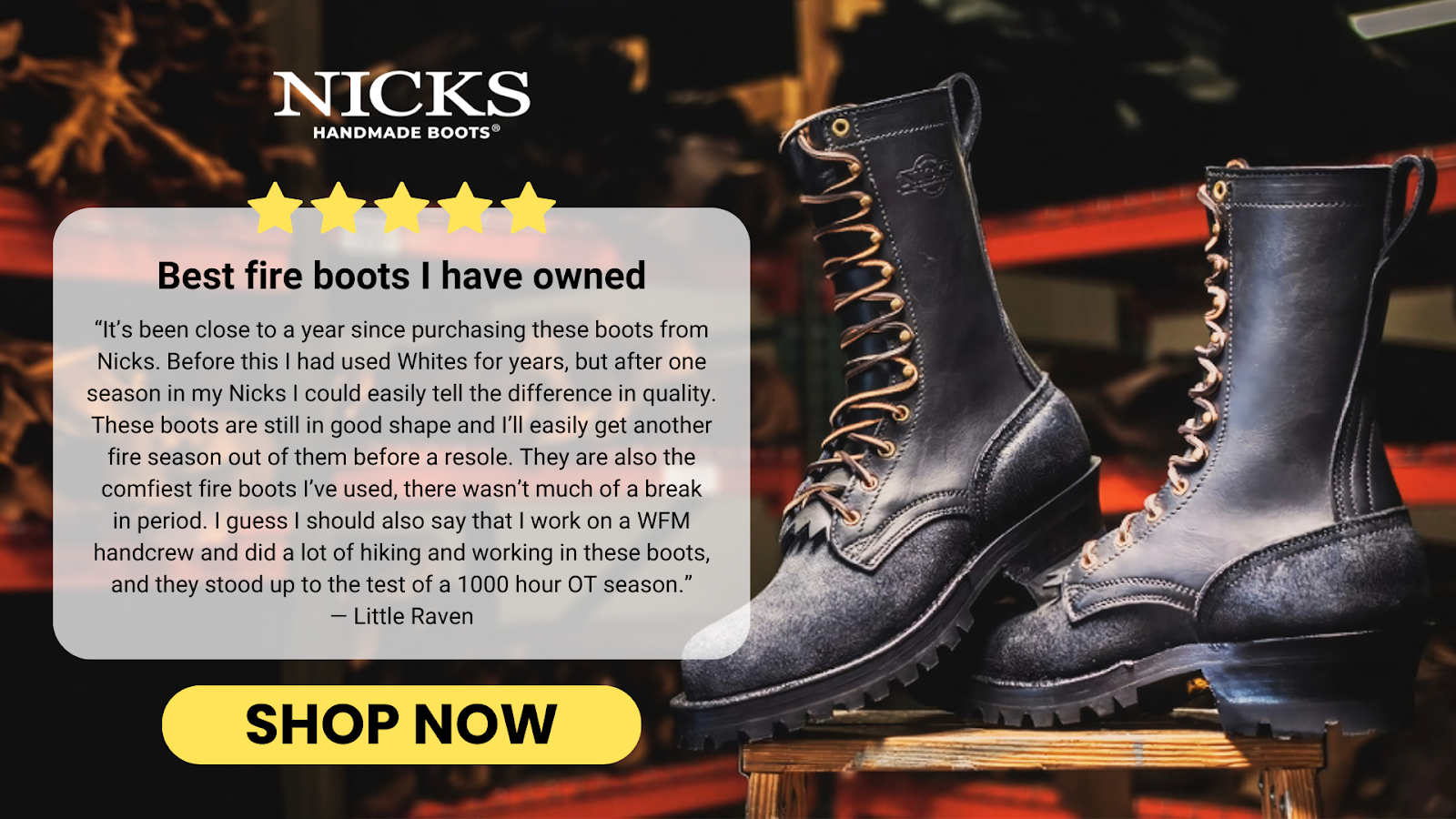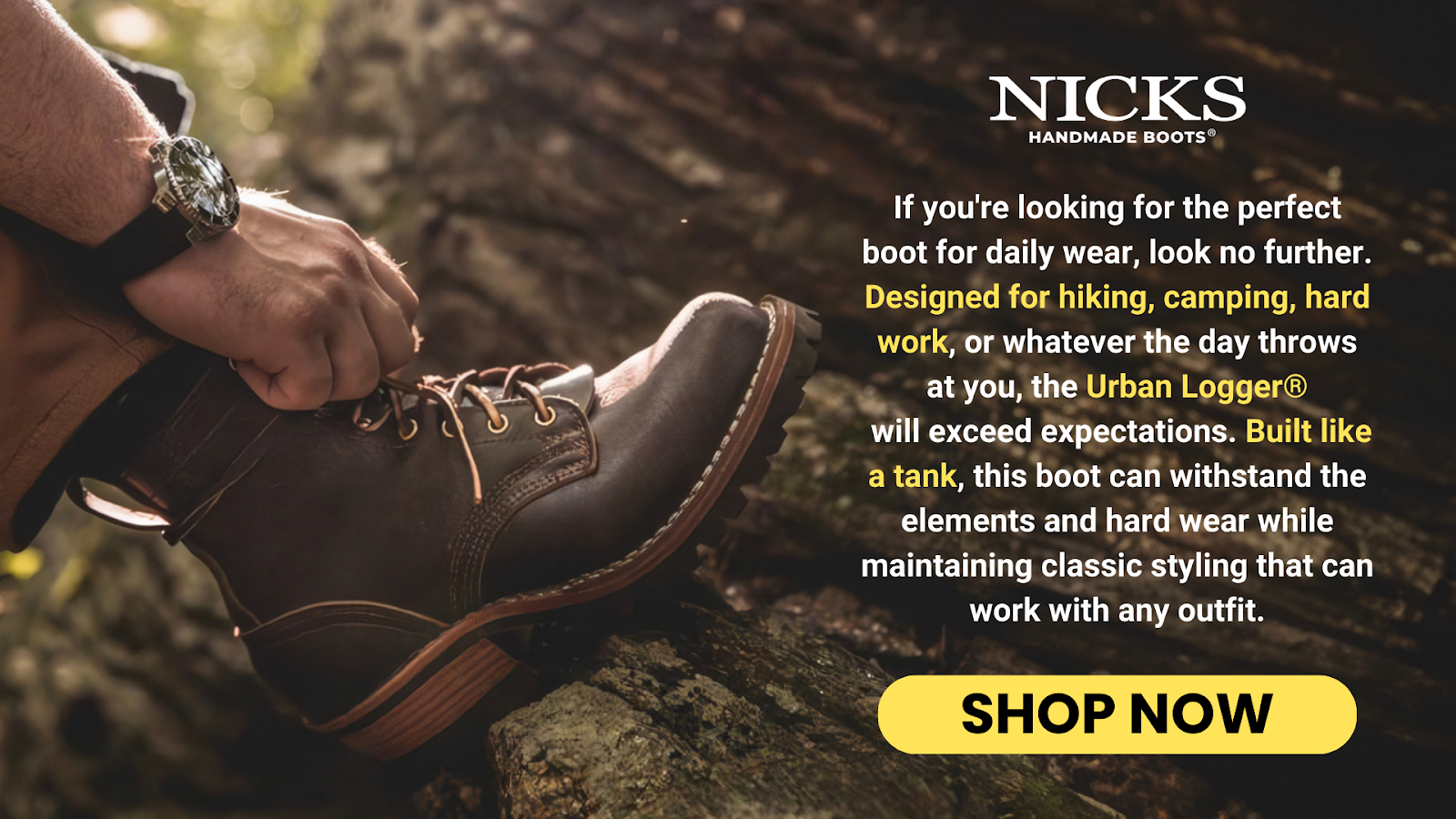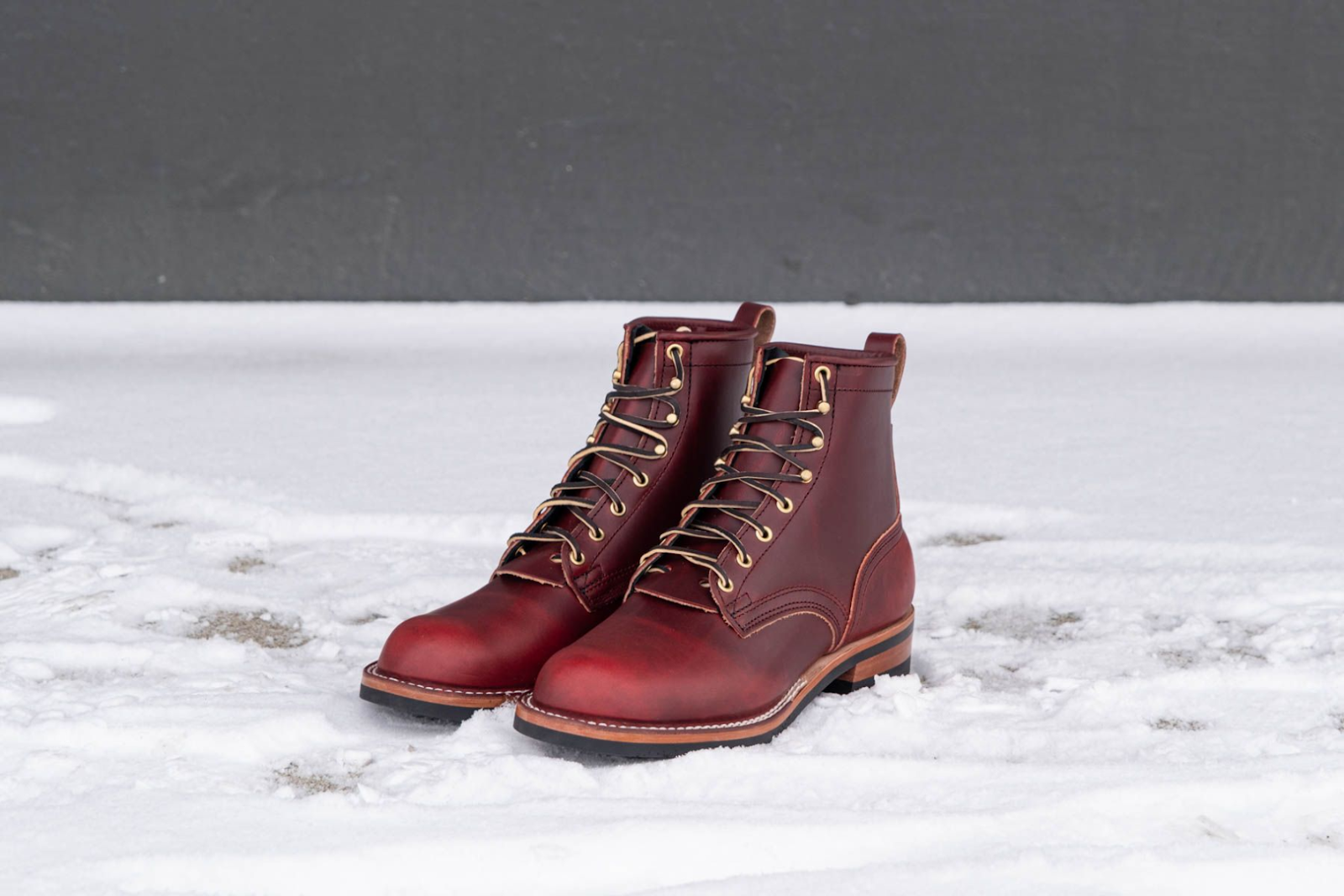Key Takeaways:
- Material Matters: Understanding the specific needs of the material of your boots is crucial for proper maintenance and extending their lifespan.
- DIY Repair Techniques: Simple DIY repair techniques can save you both time and money, allowing you to extend the life of your boots significantly.
- Knowing When to Replace: Recognizing the signs that your boots need to be replaced can prevent discomfort and injury, ensuring optimal performance and safety.
At Nicks Boots, we pride ourselves on crafting high-quality, durable boots designed to meet the demands of even the most rigorous work environments. With decades of expertise in handcrafting leather boots, we understand that maintaining your boots is as crucial as their initial craftsmanship.
In this guide, we'll talk about the essential tips for identifying common issues with your boots, how different materials affect their longevity, and practical steps for care and maintenance. Additionally, we'll provide easy-to-follow DIY repair tips and advice on when it’s time to consider replacing your boots. Whether you're navigating rugged terrains or enduring long hours on the job site, our insights will help keep your Nick’s Boots in peak condition, ensuring they continue to serve you well.

Identifying Common Issues with Boots
Recognizing the signs that your boots are no longer performing as they should can help you take timely action to fix or prevent further damage. Here are some common issues to look out for:
Worn-Out Soles
The soles of your boots can wear down over time, leading to decreased traction and comfort. Look for smooth areas, especially on the heel and ball of the foot, where the grip appears significantly reduced. Continuous wear without adequate tread can increase the risk of slips and falls, particularly in wet or icy conditions. Regular inspection and timely replacement of worn soles can prevent accidents and maintain boot functionality.
Cracking Or Splitting Leather
Leather boots may show signs of cracking or splitting if not properly moisturized or if exposed to extreme conditions. This not only affects the boot’s appearance but also its ability to protect and provide comfort. Regular conditioning with a suitable leather conditioner helps preserve the elasticity and integrity of the leather, ensuring the boots remain durable and waterproof over time.
Water Intrusion
If your boots start to let in water, it could be due to compromised waterproofing or microscopic holes and tears. This is particularly common in boots used in wet environments or those that have not been properly maintained. Waterproofing treatments should be reapplied periodically to maintain effectiveness, and any holes or tears should be repaired promptly to avoid further damage and discomfort.
Stitching Coming Undone
Check the stitching on your boots regularly. If you notice any loose threads or sections where the stitching has come undone, this can quickly lead to more significant structural problems. Early detection and repair of damaged stitching can prevent the need for more extensive and costly repairs, preserving the boots' structure and appearance.
Interior Wear
Inside wear, such as a flattened insole or torn lining, can greatly affect comfort and fit, which in turn impacts boot functionality. Replacing insoles and repairing linings are relatively simple ways to refresh your boots' interior and restore comfort. Regular checks can help you identify these issues before they cause discomfort or affect your mobility.
Understanding Boot Materials And Their Impact On Durability
The material from which your boots are made plays a crucial role in their durability, comfort, and care requirements. Here's a breakdown of common materials used in boots and how they impact these factors:
Leather
Leather is a popular choice for boots due to its durability and flexibility. However, it requires regular maintenance, including cleaning and conditioning, to prevent drying and cracking. Leather boots are ideal for robust protection but can be susceptible to water damage if not treated with a waterproofing agent. Over time, well-maintained leather can develop a pleasing patina that many find aesthetically appealing, adding character to the boots.
Synthetic Materials
Synthetic boots, often made from materials like nylon or polyester, are lighter and usually cheaper than leather. They dry faster and require less maintenance but may not offer the same level of durability and protection as leather. Synthetics are often preferred for their ease of care and resistance to bacterial growth, making them suitable for damp environments and regular, heavy use.
Rubber
Rubber boots are excellent for wet conditions, providing superior waterproofing inherently. However, they can be less breathable and may lead to discomfort in hot conditions or during long periods of wear. Rubber is highly resistant to abrasions and chemical exposures, making these boots a favorite in industries that require spill protection.
Suede
Suede boots offer a softer, more flexible fit than traditional leather, but they are more vulnerable to stains and water damage. Regular brushing and specific suede protectants are necessary to maintain their appearance and functionality. Suede requires careful handling to preserve its delicate nap and rich texture, which can be easily marred by improper care.
Combination Materials
Many boots feature a combination of materials to balance durability, weight, and cost. These may require specific care strategies to ensure all materials are properly maintained. Combining materials such as leather with synthetics can enhance the boots' properties, such as increasing breathability while maintaining structural integrity. This approach allows manufacturers to design boots that meet specific needs, such as flexibility and lightweight, without sacrificing overall durability.
Proper Care And Maintenance For Your Boots
Maintaining your boots is essential to extending their lifespan and ensuring they remain comfortable and functional. Here are key tips to help you properly care for your boots:
Regular Cleaning
Dirt and grime can break down the materials of your boots, especially leather. Clean your boots with a soft brush or a damp cloth after each use. For tougher stains, use a cleaner specifically designed for the boot's material. This regular cleaning prevents buildup that can degrade the material and ensures that your boots look good and last longer.
Conditioning
Leather boots benefit greatly from regular conditioning to keep the leather supple and prevent cracks. Use a quality leather conditioner every few months, depending on how often you wear your boots. Conditioning not only restores moisture lost during wear but also enhances the leather's natural resilience against wear and tear.
Drying
Never dry your boots by direct heat as it can cause the materials to warp and crack. Instead, let them air dry naturally and stuff them with newspaper to absorb moisture and maintain shape. This method ensures that the boots dry without losing their form or causing damage to the leather or other materials.
Waterproofing
Applying a waterproofing treatment can extend the life of your boots and keep your feet dry. This is especially important for boots frequently used in wet conditions. Reapply waterproofing as needed, typically every few months for regular use. Regular waterproofing not only keeps your feet dry but also prevents water damage to the materials of your boots.
Storage
Store your boots in a cool, dry place away from direct sunlight. If you won't be wearing them for an extended period, fill them with boot trees or similar to help maintain their shape. Proper storage prevents the boots from deforming and cracking, ensuring they are ready and in good condition when you need them again.
Regular Inspections
Periodically check your boots for signs of wear and tear. Addressing issues like loose soles or damaged stitching early can prevent more significant problems later. Keeping an eye on the condition of your boots allows you to address minor issues before they turn into major ones, saving you time and money in the long run.
DIY Repairs For Minor Boot Problems
Sometimes, your boots need a bit of TLC to keep them going. Here are some DIY repair tips for common issues that don't necessarily require a professional fix:
Sole Repairs
If the soles of your boots are starting to come loose, shoe glue can be a quick fix. Make sure the area is clean and dry before applying a strong adhesive designed for shoe materials. Clamp the sole and upper together until the glue sets for a firm hold. This repair can restore the structural integrity of your boots and prevent moisture and dirt from entering through the gaps, further damaging the boot.
Minor Leather Scratches And Scuffs
For small scratches on leather boots, a simple shoe polish that matches the color of your boots can work wonders. Apply the polish with a soft cloth and buff until the scratch blends into the rest of the boot. This not only improves the appearance of your boots but also provides a protective layer that can help shield the leather from future damage.
Patch Small Holes
Nylon or canvas boots with small holes can be patched with a sewing kit or specialized patches. Ensure the patch covers the hole completely and is secured with a waterproof adhesive if necessary. This method prevents the holes from enlarging and compromising the functionality of the boots, particularly in keeping your feet dry and protected from environmental elements.
Replacing Laces
Frayed or broken laces can be easily replaced. Choose laces that match the original in length and style to maintain the integrity and look of your boots. Replacing worn laces not only refreshes the look of your boots but also ensures they fit securely, providing better support and preventing potential tripping hazards.
Refreshing Waterproofing
Reapply a waterproof spray or wax to your boots regularly, especially after cleaning them. This helps maintain their resistance to water and moisture, which is crucial for their longevity. Regular waterproofing is essential, particularly if you frequently encounter wet conditions, as it helps to keep your feet dry and prolongs the life of your boots by preventing water damage.
When To Replace Your Boots
Even with meticulous care and occasional repairs, there comes a time when boots need to be replaced. Recognizing these signs can ensure your safety and comfort. Here are key indicators that it’s time for new boots:
- Irreparable Damage: If your boots have sustained significant damage, such as large tears in the upper, a sole that has split completely, or severe structural damage that cannot be easily fixed, it’s time to consider replacing them.
- Persistent Discomfort: Boots that no longer provide adequate support or cause pain, even after trying insoles or other adjustments, may have lost their structural integrity. Continued use can lead to discomfort and foot problems.
- Compromised Waterproofing: Over time, waterproof boots may lose their effectiveness, and repeated applications of waterproof treatments may no longer do the trick. If keeping your feet dry becomes an issue, new boots may be necessary.
- Worn Outsole: The tread on the soles of your boots is crucial for safety, especially in hazardous or slippery environments. If the tread is significantly worn down, it's safer to replace the boots rather than risk a fall.
- Outdated for Your Needs: Sometimes, your boots may no longer be suitable for your current activities or climate. Upgrading to a pair that better suits your current situation can be a wise decision.
Replacing your boots when needed is an investment in your comfort, performance, and safety. By monitoring their condition and understanding these signs, you can make an informed decision about when to invest in a new pair.
Final Thoughts
Maintaining and caring for your boots is key to extending their lifespan and ensuring they continue to serve you well in all your activities. From regular cleaning and conditioning to knowing when to undertake DIY repairs, every step you take helps preserve your footwear. However, it's also important to recognize when repairs are no longer sufficient and replacement becomes necessary for safety and comfort. By staying vigilant and proactive about your boots' condition, you can ensure that your investment is well-protected and continues to meet your needs.

Read also:
Frequently Asked Questions About Boot Maintenance And Repair
What should I do if my boots begin to emit an odor?
If your boots start to smell, consider using a specialized boot deodorizer or sprinkling baking soda inside them overnight to absorb the odors. Ensuring they dry out completely between uses also helps prevent bacteria growth that can cause smells.
Can I use regular household glue for boot repairs?
It's best to use glue specifically designed for shoe repairs, such as contact cement or a shoe adhesive, as these products provide the necessary flexibility and weather resistance that household glues lack.
How often should I replace my boot insoles?
Replace insoles when they show signs of wear, typically every 6-12 months, depending on usage, to ensure proper foot support and comfort.
Is it okay to wash boots in a washing machine?
Washing boots in a washing machine is generally not recommended as it can damage both the machine and the boots. Stick to hand cleaning using appropriate methods for the boot material.
Can I dry my boots in the sun after washing them?
Drying boots in direct sunlight can cause the material, especially leather, to crack and fade. It’s better to dry boots in a well-ventilated area away from direct heat or sunlight.
What is the best way to store boots long-term?
For long-term storage, clean and condition your boots first, then store them in a cool, dry place with boot trees or supports to maintain their shape.
How can I make my boots slip-resistant?
Apply a slip-resistant coating available at shoe stores or online. Alternatively, you can attach adhesive grip pads to the soles to enhance traction.
What should I do if the color of my leather boots fades?
If the color of your leather boots fades, applying a colored leather cream or polish that matches your boots can restore their appearance.
Are there any home remedies for waterproofing boots?
As a home remedy, beeswax can be applied to boots to enhance water resistance. Ensure the boots are clean and warm the wax slightly to help it penetrate the material.
How do I deal with salt stains on winter boots?
To remove salt stains, mix equal parts water and white vinegar, apply the solution gently with a soft cloth, and let the boots dry naturally away from heat.





































